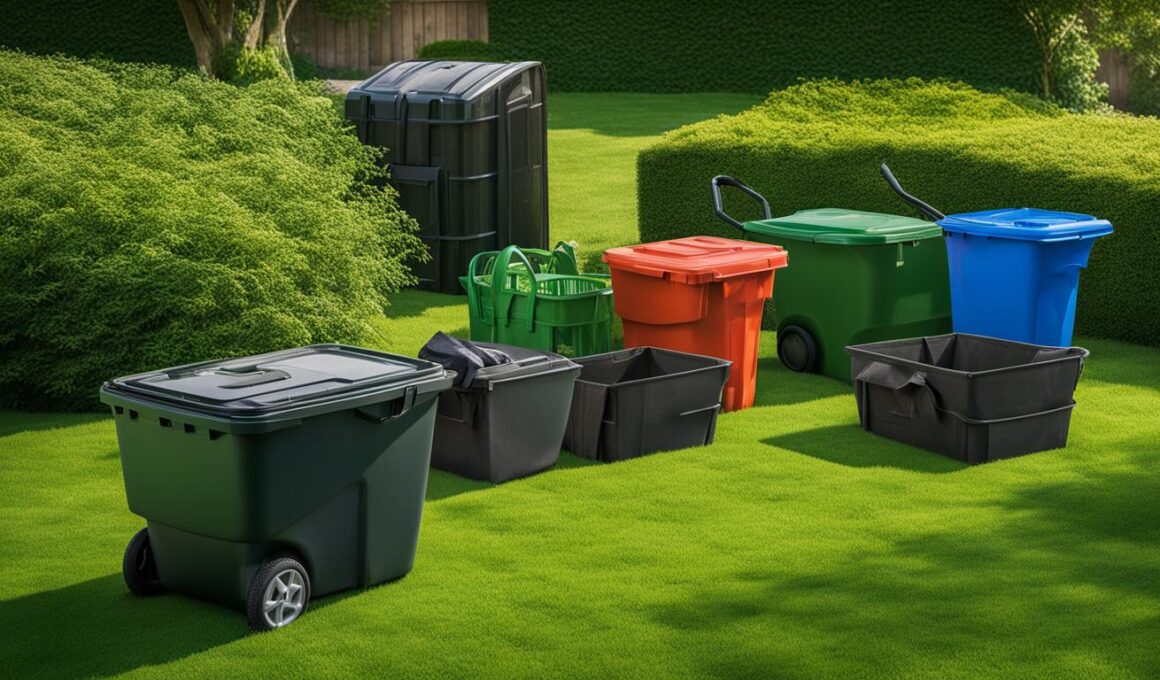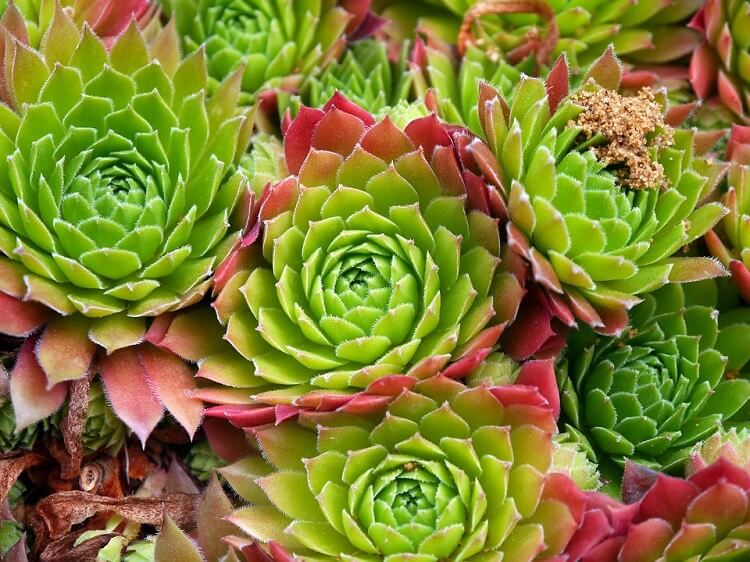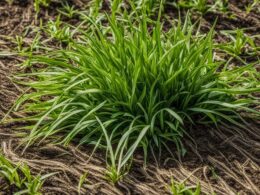After mowing your lawn, you may find yourself wondering how to best dispose of those grass clippings. Rather than discarding them carelessly, consider environmentally friendly and beneficial methods that improve your lawn and garden’s overall health. Discover lawn care techniques that make the most of your grass clippings, from recycling them back onto the lawn to creating nutrient-rich compost, while promoting eco-friendly yard maintenance practices.
Key Takeaways
- Recycling grass clippings back onto the lawn helps conserve fertilizer and improves soil structure.
- Mowing at the right frequency is essential in preventing excessive grass clippings.
- Grass clippings do not cause thatch buildup, a common misconception in lawn care.
- Composting grass clippings provides nutrient-rich additions to garden soils.
- Using dry grass clippings as a natural mulch for garden beds helps conserve soil moisture.
- Proper disposal of diseased or herbicide-treated clippings prevents the spread of weeds or diseases.
- Eco-friendly lawn care practices contribute to healthier, more vibrant lawns and gardens.
Understanding the Benefits of Grass Recycling
Recycling grass clippings by leaving them on the lawn is a sustainable practice that offers various advantages for lawn sustainability, fertilizer reduction, and soil health. These benefits make grass recycling an eco-friendly and cost-effective option for homeowners who seek a healthy and vibrant landscape.
Some key benefits of grass recycling include:
- Contribution to lawn fertility through nutrient provision
- Improved soil structure and water retention
- Decreased need for synthetic nitrogen fertilizers
- Creation of a healthier lawn ecosystem
Let’s explore these benefits in greater detail.
Contribution to Lawn Fertility through Nutrient Provision
Grass clippings provide valuable nitrogen to the lawn, which contributes to reducing the need for supplemental nitrogen fertilizers. This conservation not only saves you money on fertilizer but also benefits the environment by decreasing nutrient pollution in water bodies.
Improved Soil Structure and Water Retention
Grass clippings improve soil structure, especially in sandy or heavy clay soils, by adding organic matter that decomposes and enhances the soil’s fertility and water-retaining capabilities. This process leads to healthier, more robust grass roots and a greener, more vibrant lawn.
Decreased Need for Synthetic Nitrogen Fertilizers
As mentioned earlier, grass clippings provide a natural source of nitrogen to your lawn, reducing your reliance on synthetic nitrogen fertilizers. This not only saves you money but also helps protect the environment from excessive nutrient pollution.
Creation of a Healthier Lawn Ecosystem
Grass recycling fosters a healthier lawn ecosystem by promoting the growth of beneficial organisms such as earthworms and microbes. These organisms enhance the soil’s health further by breaking down and incorporating clippings into the soil, improving overall lawn sustainability.
| Benefit | Description |
|---|---|
| Nutrient Provision | Grass clippings provide valuable nitrogen to the lawn. |
| Soil Structure Improvement | Clippings improve soil structure by adding decomposable organic matter. |
| Fertilizer Reduction | Natural nitrogen in grass clippings helps decrease the need for synthetic fertilizers. |
| Healthier Lawn Ecosystem | Grass recycling supports the growth of beneficial organisms, improving overall soil health and lawn sustainability. |
In conclusion, grass recycling is a beneficial and eco-friendly practice that promotes lawn sustainability, fertilizer reduction, and soil health. By embracing this practice, homeowners can cultivate a more resilient lawn ecosystem and enhance the overall health of their landscape.
Proper Techniques for Mulching Your Lawn with Clippings
Mulching your lawn involves recycling grass clippings back onto the lawn, providing nutrients and benefits to the soil and grass. To achieve optimal results, it’s important to adjust the mulching mower settings and use suitable lawn mulching techniques. In this section, we will discuss how to optimize your mower settings to create the ideal grass clipping size and dispel the common myth about clippings causing thatch.
Adjusting Mower Settings for Optimal Clipping Size
For mulching to be most effective, it’s essential to adjust your mower settings according to the desired grass clipping size. The ideal grass clipping size is 1-inch or less in length. When clippings are this size, they can filter down to the soil surface and decompose quickly without smothering the grass below. To ensure you’re creating optimal grass clippings, use the following steps:
- Set your mower blade height to remove no more than a third of the grass height with each mowing.
- Keep the mower blades sharp to ensure clean, even cuts.
- Choose a mulching mower with adjustable settings that allow you to customize the clipping size.
Following these recommendations will result in shorter grass clippings that contribute beneficially to lawn health without causing problems such as thatch buildup.
| Mowing Height | Blade Sharpness | Mulching Mower |
|---|---|---|
| Remove no more than a third of grass height | Regularly sharpened blades | Adjustable settings for clipping size |
The Myth of Thatch: Why Clippings Don’t Cause Harm
Thatch is a layer of organic material that accumulates on the surface of lawns, which can be problematic if it becomes too thick. A common myth in lawn care is that leaving grass clippings on the lawn will contribute to thatch buildup. However, this is not true.
Grass clippings decompose quickly due to their high water content and easily decomposable compounds. As they break down, they release nutrients back into the soil and do not contribute significantly to the thatch layer.
Thatch accumulation is typically caused by factors such as excessive watering, compacted soil, and infrequent mowing. Proper management of these factors, alongside maintaining optimal grass clipping size and ensuring a healthy lawn, will prevent the formation of a problematic thatch layer.
Creating Nutrient-Rich Compost with Grass Clippings
Grass clippings compost is an excellent way to recycle your yard waste, turning it into valuable, nitrogen-rich compost that benefits your garden. With backyard composting, you can convert clippings into nutrient-rich soil amendments, particularly after periods of no mowing, which may result in more significant cleanup tasks. To ensure proper decomposition, it is essential to balance the high nitrogen content of grass clippings with carbon-rich materials such as fall leaves or newspaper. This will prevent odors and ensure a healthy decomposition process in your compost pile. The resulting compost enriches garden soil and contributes to a healthier garden ecosystem.
When creating a grass clippings compost, it’s crucial to maintain the proper carbon-to-nitrogen (C:N) ratio. Grass clippings are high in nitrogen, so it’s essential to mix them with carbon-rich materials to achieve the recommended C:N ratio of 25-30:1. This balance facilitates the efficient decomposition of the clippings and maintains a pleasant odor during the process.
- Gather grass clippings and carbon-rich materials like fall leaves, shredded newspaper, or cardboard.
- Layer the materials in your compost bin, starting with a layer of carbon-rich materials at the bottom, followed by a layer of grass clippings. Continue alternating layers of carbon and nitrogen materials.
- Monitor the moisture content of your compost. It should be damp, like a wrung-out sponge. If it’s too dry, add water. If it’s too wet, include more carbon-rich materials.
- Turn your compost regularly using a compost fork to aerate the pile and stimulate decomposition. Depending on the size of your pile and the materials used, this may be necessary every one to two weeks.
Grass clippings compost can benefit your garden in various ways:
- Supplies essential nutrients to soil and plants
- Promotes the growth of beneficial microorganisms
- Improves soil structure
- Enhances moisture retention in sandy soils
- Loosens heavy clay soils for better aeration
- Recycles organic waste and reduces landfill input
In conclusion, grass clippings compost is a valuable addition to any backyard composting setup. By carefully balancing carbon and nitrogen materials, you can create nutrient-rich compost that benefits your garden and supports a healthier ecosystem. Not only are you recycling valuable yard waste, but you’re also improving the health and fertility of your garden soil.
Using Grass Clippings as a Natural Mulch for Garden Beds
Utilizing grass clippings mulch provides significant benefits to your garden. It serves as an affordable and eco-friendly alternative to store-bought mulch, providing insulation, soil moisture conservation, and improved soil structure. When correctly applied, grass clippings decompose to enrich the soil, promoting a healthier and more productive garden.
Best Practices for Applying Grass Clippings as Mulch
For optimal results when using grass clippings as natural garden mulch, follow these best practices:
- Dry the clippings: Spread freshly-cut grass clippings in a thin layer to dry in the sun for a day or two before using them as mulch. Wet clippings can form a dense mat, impeding water and oxygen flow to plant roots.
- Apply a thin layer: Avoid burying your plants or smothering your soil by applying a layer of grass clippings that is 1 to 2 inches deep.
- Avoid seeding: If your lawn has gone to seed, wait until the seeds have dropped before using those grass clippings as mulch to prevent unwanted growth in your garden beds.
In addition to the general guidelines above, consider the specific needs of your garden plants when applying grass clippings as mulch. Some plants may require a more substantial layer, while others might do best with a thinner layer.
| Types of Plants | Ideal Mulch Thickness | Additional Tips |
|---|---|---|
| Vegetables | 1-2 inches | Keep mulch away from plant stems to prevent rot. |
| Shrubs | 2-3 inches | Apply mulch in a donut shape, leaving a space between the mulch and the trunk. |
| Perennials | 1 inch | Apply mulch after plants have emerged; avoid covering new shoots. |
| Annuals | 1 inch | Mulch after planting to help conserve soil moisture. |
By incorporating grass clippings mulch into your garden maintenance routine, you will not only save money and reduce waste but also foster healthier soil and more vigorous plant growth. Follow these best practices to make the most of your grass clippings and achieve a beautiful, flourishing garden.
When to Remove Grass Clippings and Alternatives for Disposal
Sometimes, grass clipping removal from the property is necessary, particularly when dealing with disease-infested or herbicide-treated lawns or when the lawn contains many weeds. In these cases, rather than leaving clippings as mulch or in the compost, it is essential to remove them to prevent the spread of weeds or disease. If removal is necessary, yard waste alternatives such as local yard waste recycling programs can be an eco-friendly disposal option compared to sending it to landfills.
There are several conditions that require grass clipping removal:
- Disease-infested lawns
- Herbicide-treated lawns
- Lawns with excessive weeds
To prevent the spread of disease or weeds in your lawn, consider the following disposal alternatives:
- Local yard waste recycling programs
- Community composting sites
- Green waste pickup services provided by waste management companies
| Disposal Method | Benefits | Drawbacks |
|---|---|---|
| Local yard waste recycling programs | Eco-friendly, supports local waste management efforts | May have specific guidelines or restrictions, potential fees |
| Community composting sites | Promotes sustainable practices, contributes to local compost production | May not be available in all communities, could have limitations or regulations |
| Green waste pickup services | Convenient, keeps yard clean and free of disease or weed spread | Frequent service might generate costs, may require proper containment methods |
While grass clipping removal may not always be necessary, it is crucial to analyze the condition of your lawn and consider eco-friendly disposal options when needed. Doing so will aid in maintaining a healthy, thriving lawn while minimizing environmental impact.
Can I Use Grass Clippings as Mulch for Belgian Mums?
Yes, grass clippings can be used as mulch for Belgian mums. However, it’s important to understand the Belgian mums true nature as they prefer well-draining soil. To prevent mold or mildew, allow the clippings to dry out before applying around the mums. This will enhance the soil’s health and aid in moisture retention.
Conclusion
Managing grass clippings effectively is crucial to maintaining a healthy and eco-friendly lawn. By practicing proper grass clipping management techniques, you can reap the benefits of a vibrant and sustainable green space.
There are a variety of options to consider, such as recycling clippings back onto the lawn, incorporating them into compost, or using them as organic mulch for garden beds. All these approaches contribute to increased lawn health and soil structure, in line with lawn maintenance best practices.
If faced with situations where your grass clippings are contaminated by weeds or chemicals, it’s important to remove them responsibly. Look for local yard waste recycling programs or other environmentally-friendly disposal methods. Embracing eco-friendly lawn care practices significantly benefits both your yard and the environment, resulting in a greener, healthier garden for all to enjoy.











